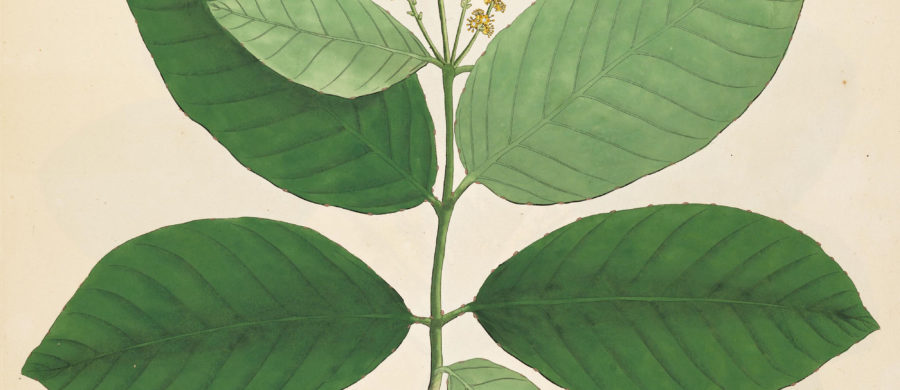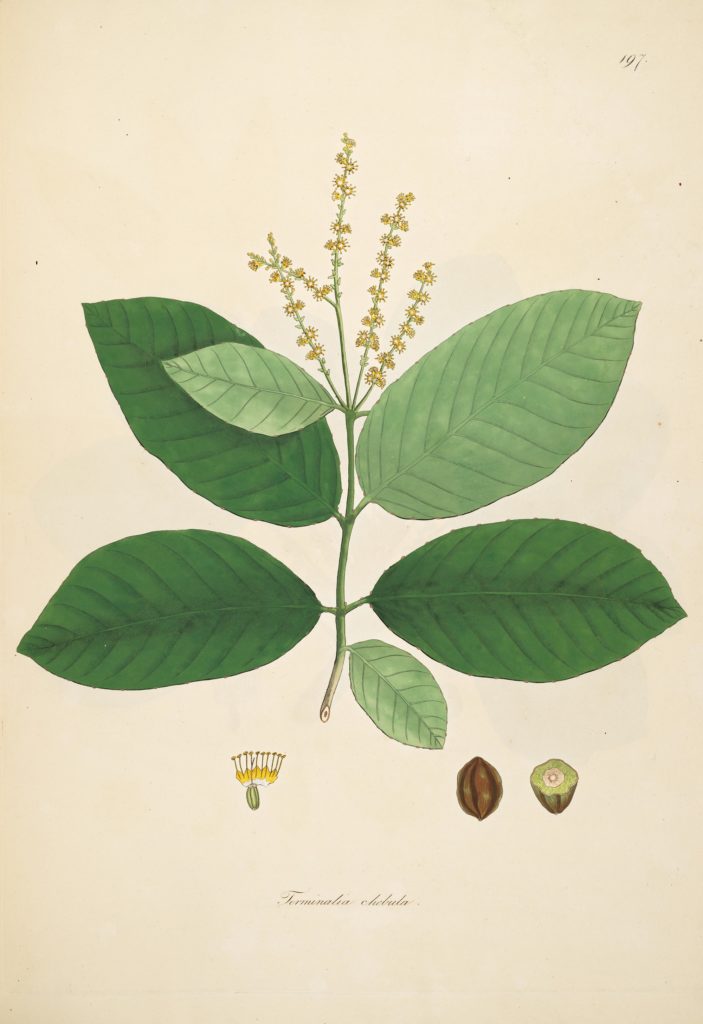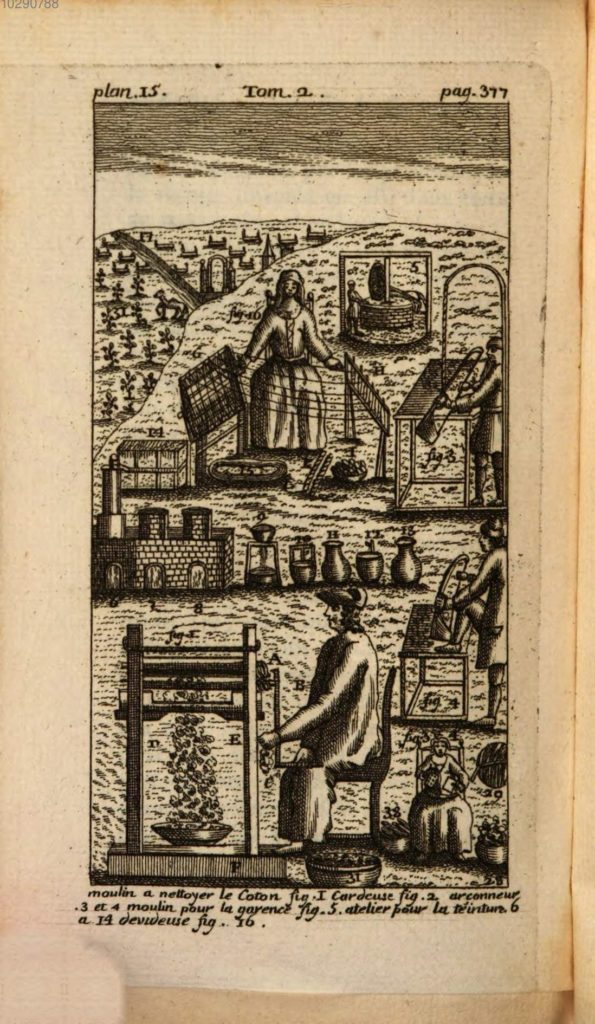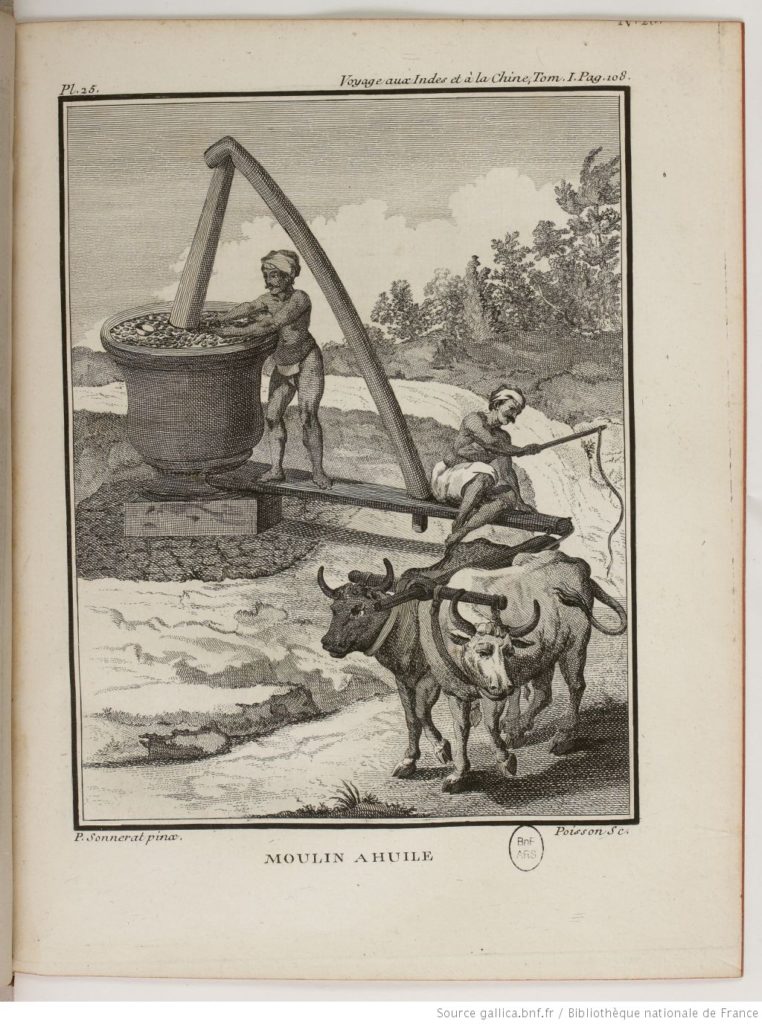
Western Travelers Describe Foreign Textile Practices
Technology’s Stories v. 7, no. 2 – DOI: 10.15763/jou.ts.2019.06.13.03
PDF: Lowengard_Western Travelers
The interested bystander is a familiar presence in narratives of information exchange in the early modern period. The observations of expatriates writing home, officials on government-sponsored tours, merchants and traders were constant and often significant components to stories about dissemination of techniques across distant geographies. At the same time, espionage, importing (or exporting) workers and dogged trial and error were part of their capture and integration “back home.”
How does the non-specialist decipher unfamiliar actions? How, especially, if the goal is to inform those unable to observe the practices but who might wish to exploit the technique in some way? Interpretation may depend on what the observer is permitted to see or what s/he is told and how s/he understands it, but the parameters of comprehension incorporate more than a relationship between observer and the person or action under observation. Can the observer determine and provide what the reader must know?
One way to explore these questions is to compare interpretations of a single craft process. Here, I look at three descriptions of an 18th century technique to make the bright red color on cotton fibers known in the West as Turkey red, Indian red or rouge d’Andrinople. Each observer-collector wrote about the set or system of processes that created this attractive and desirable color; each acknowledged its reputation as a difficult process to complete with success. The differing motivations of the observers led to overlapping, but still diverse, interests and approaches. Personal understanding—of their observations and of the state of Turkey red dyeing at the time of publication—proved to be important in each presentation.
![Interest in the processes to create a vibrant and lasting red color on cotton remained high in Europe throughout the 18th century. These Turkey red samples were submitted to the Society for the encouragement of Arts Trades and Manufactures in London by Jean Conrad [Pfenninger] & Peter [?] of Zurich, 26 April 1773. Royal Society of Arts archive. RSA/PR/GE/110/30/179](https://www.technologystories.org/wp-content/uploads/2019/06/Lowengard_Image_1-1024x800.jpeg)
The outline of the Turkey red process recommended in the 18th century was consistent throughout the regions of its origin (Persia, India and Asia Minor), with some adaptations to local climates and products. Thoroughly washed (scoured) cotton yarns must be steeped in four substances: animal entrails or effluents, tannin, alum and finally the dyestuff madder. Each steeping may be repeated but washing and resting periods occur between every application. A final scouring removes the unattached dye and exposes an attractive strong red color.
 Loading…
Loading…
The devil is in the details, however, and 18th century dyers in Europe found both the bright shade and its tenacity difficult to replicate. Throughout that century, in addition to espionage and experiment, interest in how they did it (they being dyers in Thessaloniki, Astrakhan, Izmir, Hurryhur, Puducherry and elsewhere) continued. The reputation of Turkey red was such that reports continued to be made, and new adaptations continued to be proposed, even after the Turkey red process was claimed as a specialty in regions of England and France.
I. Père Cœurdoux (1691-1779) Watches Over His Ministry
“For a long time, Europe has sought the art of fixing colors, and of giving them that adhesion which we admire in the cloths of the Indies,” wrote Gaston-Laurent Cœurdoux in January 1742.[1] In a letter published in Lettres édifiantes et curieuses, the Jesuit missionary described the technique followed in Pondichéry (Puducherry) to create permanent and bright red colors on the cotton textiles known as indiennes. Cœurdoux’s letter indicated his desire to improve understanding of this process because it represented local industriousness; perhaps its techniques might be useful to European commercial interests. Cœurdoux’s presentation exposed a greater familiarity with the reputation of red-colored cottons than with the objects or their technical processes. He observed workers and discusses details with informants, two recently-baptized (and so trustworthy) men skilled in the dyeing operations. To further “the progress of the Sciences,” he tested an ingredient deemed significant to a good result, one not native to France.[2]
Cœurdoux described all aspects of indiennage, with special attention on the preparation and coloring of the cloth. He identified two kinds of operations. “Interior” treatments ensured that color adheres to fiber in the dyeing stage. Interior operations, which included soaking or boiling the cloth in sheep dung or other animal substances, in tannin-rich cadou, and in alum, made chemical changes to the fibers.[3] The “external” steps, folding and beating the cloth, effected a physical change that ensured a smooth surface for the painted elements of the design.
 Loading…
Loading…
To meet his goal of clarifying a foreign process others cannot observe, Cœurdoux translated measurements and operations into French equivalents. Quantities were problematic, as they must be increased or decreased “according to the need and quantity of the cloths.”[4] Should one use 25 cadou per length of cloth or three palam? He had no means to make standard something that was decided by experience, and so he offered both. In other instances, Cœurdoux compared actions made on (or to) substances used in the dyeing process with activities that might be more familiar to the reader. For instance, he described the Indian method of pulverizing substances as similar to rolling patisserie, and he related the action of a solution of cadou in buffalo milk to the way that starch was employed in papermaking to coat the surface so it accepts but doesn’t absorb ink.

Cœurdoux turned from his observer status to conduct experiments on cadou, with a goal of aiding identification of a European substitute. Could gall nuts, or medlars picked and dried before their maturity, or pomegranate bark serve the same purpose?[5] He investigated, but was unable to reach a determination, leaving the answer and perhaps further study to the imagination of his reader.
II. Jean-Claude Flachat (1718-1775) Protects His Interests
About the time that Cœurdoux observed, catalogued and experimented with the red cotton production processes on the east coast of India, Jean-Claude Flachat began a multi-year journey from Saint-Chamond, near Lyon. He traveled through Europe, Asia Minor and North Africa. Observations sur le commerce et sur les arts d’une partie de l’Europe, de l’Asie, de l’Afrique, et même des Indes Orientales, a two-volume work describing Flachat’s travels, was published in 1766, more than a decade after his return.[6]
Flachat also observed with an eye on usefulness and commerce. His published observations emphasized the latter, as might suit a protégé of Henri Bertin, Intendant of the Généralité of Lyon and Daniel Trudaine, then Director of Commerce and a sponsor of Flachat’s journey.[7] In his book, Flachat offered anecdotes about the culture and political economy of the places he visited, including Scandinavian and German states, Hungary, Russia and the Ottoman Empire with an extended period in Constantinople. He described manufacturing practices and tools, including information about mills, boats and international shipping.
Flachat’s notions about useful technologies of textile production are more personal than those of Cœurdoux, as they can be connected to his experiences and expectations as a manufacturer. He, too, relied on specialist informants, but he learned the processes and also brought workers as well as ideas and commodities home to Lyon. His émigré experts included “two Turkey red dyers, two tinsmiths from Constantinople, a Persian spinner and a cotton bower from Smyrna.”[8] He also sponsored Armenian makers of “vitriol de Chypre”—blue vitriol or copper sulfate, another commercial interest of the Flachat family.[9]

Flachat described two different technologies connected to his experiences and interests “at home.” On his return to St. Chamond in the late 1750s, Flachat and his brother François (1730-1790) had established a Royal manufacture dedicated to dyeing “all kinds of cotton, silk, horsehair, linen, etc.,” but especially Turkey red (rouge d’Andrinople).[10] His book included a description of the technique within his observations of dyeing and textile practices. The instructions contained no new observations, however; they are nearly identical to a mémoire issued by the French government in 1765.[11] Is this coincidence, or was Flachat closely involved in the official instructions? Was he determined to protect whatever special methods his royal privilège granted? Is this why he included the privilège in the book? Flachat also neglected to explain how the red dyeing process might differ for silk or horsehair, both protein-based fibers that can require different substances and techniques from cotton and linen.
Flachat included an image of tools he encountered in his description of the Turkey red process and this image also suggests his interest in preserving information. The plate was loaded with images relating to Levantine techniques for cotton production. It hinted at Flachat’s greater interest in sharing techniques of bowingcotton, as the figures depicting that operation are larger in scale than the vats and pots required for the dyeing process. Flachat had been instrumental in establishing the practice of cotton bowing in the Beaujolais district, another clue to his varied commercially-focused observations. In his book, he noted that bowing produced a less-good result than carding but it was more rapidly completed and the results were adequate for lower-quality cotton yarns, as for the export market.
III. Peter Simon Pallas (1741-1811) Collects an Empire
Peter Simon Pallas, a German naturalist affiliated with the St. Petersburg Academy of Sciences (Akadémiya Naúk), explored the eastern and southern regions of Russia on behalf of the Empress Catherine II. Pallas recorded a wealth of information during his two expeditions, the first from 1768 to 1774, the second 1793-1794.[12] His findings appeared in multi-volume works, in the journal of the St. Petersburg Academy, in his own Neue nordische Beyträge and in other academy or savant journals. Pallas included observations about dyeing practices in the first volumes, but nothing about dyeing cotton bright red until his second, when he revisited Astrakhan. The description appeared in the Neue nordische Beyträge of 1793. An earlier version may have circulated, as the chemist Claude-Louis Berthollet and others refer to Pallas’s observations in their studies of Turkey red dyeing before that date.[13] Some years later it was translated and published in the Philosophical Magazine.[14] In those publications, Pallas’s observations were combined with other observations, some made 25 years later.
Pallas opened his description by commenting on his lack of familiarity with recent development in dyeing technologies.[15] He had collected and preserved the process because he understood that the quality of bright red colors produced on cotton goods in Asia Minor, India and Persia continued to be superior to those made in Europe (or Russia).[16] What can we learn from the techniques practiced within the Armenian community of Astrakhan? Pallas certified the accuracy of his account by noting that it was based on discussions with a friend who had provided financial backing to such a manufacture. The details—not simply weights and measures or costs, but also descriptions of the color of the cotton fibers at each stage of the process—makes it likely that Pallas observed the red dyeing process himself and that his local informant was concerned with determining standards but not involved in the production process.[17] He was better equipped to understand what he saw than Cœurdoux, and more willing to share than Flachat.
Pallas offered a thorough description of the red dyeing process, and one that does not differ in its operations from those of Cœurdoux’s and Flachat’s publications. He noted the use of fish oil, particularly that of sturgeon or shad, rather than sheep dung and sumac (rhus cotinus) rather than cadou, but does not remark on those differences. In keeping with his natural history and taxonomic expertise, Pallas included Latin names for all substances, assessed their properties within the dyeing process and described how to ensure they have been prepared properly. The fish oil, for example, must form a milky, soapy substance when Kalakar soda (another local substance) is added. Pallas did not focus on the arduousness of the process, but remarked that a well-made red color requires 21 days to complete and is carried out only during warm months of the spring into the fall.

Pallas described the tools used, as both Cœurdoux and Flachat do. The vats, similar in description to those featured in Flachat’s description and drawing, and the horse mills used to pulverize the madder, the sumac and other substances receive special attention.[18]
Pallas’s expertise with natural history materials may have increased the value of his observations for readers, and it seems to confirm its value as anecdotes rather than recipes despite the detail he provides. His description acknowledged the instructions issued by the French government and work carried out in England.[19] There was more, however. By the 1790s, a causal observation made by Cœurdoux had moved from incidental to important. Pallas credited the Tübingen physician Ferdinand-Christoph Oettinger with confirmation of the fatty nature of the mordant used.[20] This was a change from earlier descriptions, which often emphasized the need for an animalizing substance (sheep dung or fish oil and blood) to ensure a successful result.
The act of transcribing a practice or series of operations can have many motives. The purpose may be to preserve information for its own sake, as an example of something that was done at this time in that place. It may be to replicate the result, or create a facsimile of it elsewhere. Motives behind the desire to record may be to show or explain a culture, to adopt or see what could be adopted in terms of practices or materials, to provide order or administrative control, to establish precedence, even to conceal information. For each observer, explaining a foreign textile production system requires acknowledging the tools, the substances used and the techniques in which they are employed. Each “collects” the practice through observation and interaction with specialists. Collection permits assessment. Assessment permits distribution, but the effects of distribution can vary with description and with understanding.
Sarah Lowengard is a historian of technology and sciences whose research combines art, material culture and materials science with the more typical historical concerns of social life, economies and ideas. An artisan colormaker and practicing art conservator, she lives in New York City and teaches history at The Cooper Union.
Bibliography
Berthollet, Claude-Louis. Éléments de l’art de la teinture. 2 vols. Paris: F. Didot, 1791.
Cœur-Doux, père Gaston-Laurent. “Lettre du P. Cœur-Doux, missionaire de la Compagnie de Jesus, au P. du Halde de la même compagnie.” In Lettres édifiantes et curieuses: Écrites des missions étrangères, 175–219. Barbou, 1743.
Flachat, Jean-Claude. Observations sur le commerce et sur les arts d’une partie de l’Europe, de l’Asie, de l’Afrique, et même des Indes Orientales. 2 vols. Lyon: Jacquenod père et Rusand, 1766.
Henry, Thomas. “Considerations Relative to the Nature of Wool, Silk, and Cotton, as Objects of the Art of Dying; on the Various Preparations, and Mordants, Requisite for These Different Substances; and on the Nature and Properties of Colouring Matter. Together with Some Observations on the Theory of Dying in General, and Particularly the Turkey Red.” Memoirs of the Literary and Philosophical Society of Manchester, 1, 3 (1790): 343–408.
Hilaire-Pérez, Liliane. “Cultures techniques et pratiques de l’échange, entre Lyon et le Levant: inventions et réseaux au XVIIIe siècle.” Revue d’histoire moderne et contemporaine 49, no. 1 (2002): 89–114.
Jean-Claude Flachat : un collecteur de savoir au siècle des Lumières. Saint-Jean-Bonnefonds, France: La Maison du Passementier, 2008. http://www.ville-st-jean-bonnefonds.fr/IMG/pdf/catalogue.pdf.
Mémoire contenant le procédé de la teinture du coton rouge-incarnat d’Andrinople, sur le coton filé. Paris: Impr. royale, 1765. http://gallica.bnf.fr/ark:/12148/bpt6k6395722z.
Pallas, Peter Simon. Bemerkungen auf einer Reise in die sudlichen Statthalterschaften des russischen Reichs in den Jahren 1793 und 1794. Leipzig: Bey Gottfried Martini, 1984.
———. “Beschreibung des orientalischen Verfahrens die Baumwolle mit Krapp cht zu färben, wie solche in Astrachan ausgeübt zu werden pflegt: Nebst einem Anhang einiger andern Astrachanischen Färbereyen.” Neue nordische Beyträge zur physikalischen und geographischen Erd- und Völkerbeschreibung, Naturgeschichte und Oekonomie 5 (1793): 109–21.
———. “Description of the Eastern Method of Dyeing Cotton Red with Madder.” In Travels into the Southern Provinces of the Russian Empire in the Years 1793 and 1794, translated by Francis William Blagdon, 2nd., 1:233–36. for John Stockdale, 1812. http://lhldigital.lindahall.org/cdm/ref/collection/nat_hist/id/51965.
———. Reise durch verschiedene Provinzen des Russischen Reichs. 3 vols. St. Petersburg, 1771.
———. Travels through the Southern Provinces of the Russian Empire, in the Years 1793 and 1794. Translated by Francis William Blagdon. 2 vols. London : Printed for J. Stockdale, 1812. http://archive.org/details/b22008056_0002.
Pallas, Professor [Peter Simon]. “II. Process for Dyeing the Adrianople or Turkey Red, as Practised at Astracan. Being a Supplement to His Former Publications on That Art.” The Philosophical Magazine 25, no. 97 (1806): 8–9. https://doi.org/10.1080/14786440608563401.
———. “The Genuine Oriental Process for Giving to Cotton Yarn or Stuff the Fast or Ingrained Colour, Known by the Name of Turkey Red, as Practised at Astracan. . . .” Philosophical Magazine, 1, 1 (1798): 4–11.
Schweppe, Helmut. Handbuch der Naturfarbstoffe: Vorkommen, Verwendung, Nachweis. Landsberg/Lech: ecomed, 1992.
Wilson, John. An Essay on Light and Colours, and What Colouring Matters Are That Dye Cotton and Linen. Manchester [England], 1786.
[1] Cœur-Doux, “Lettre du P. Cœur-Doux,” 179.
[2] père Gaston-Laurent Cœur-Doux, “Lettre du P. Cœur-Doux,” in Lettres édifiantes et curieuses: Écrites des missions étrangères (Barbou, 1743), 175.
[3] Cadou is a nutmeg-sized, gall-like excrescence on the leaves of the ink nut or myrobalans tree. See Schweppe, Handbuch der Naturfarbstoffe, 485.
[4] Cœur-Doux, “Lettre du P. Cœur-Doux,” 176.
[5] Cœur-Doux, 179.
[6] Flachat, Observations sur le commerce et sur les arts.
[7] Hilaire-Pérez, “Cultures techniques et pratiques de l’échange, entre Lyon et le Levant,” 102; Jean-Claude Flachat : un collecteur de savoir au siècle des Lumières.
[8] Flachat, Observations sur le commerce et sur les arts, 2:356.
[9] Jean-Claude Flachat : un collecteur de savoir au siècle des Lumières, 17.
[10] Flachat, Observations sur le commerce et sur les arts, 2:397.
[11] Mémoire sur la teinture du coton rouge-incarnat d’Andrinople.
[12] Pallas, Reise durch verschiedene Provinzen des Russischen Reichs; Pallas, Bemerkungen auf einer Reise in die sudlichen Statthalterschaften des russischen Reichs in den Jahren 1793 und 1794; Pallas, Travels through the Southern Provinces of the Russian Empire, in the Years 1793 and 1794.
[13] Berthollet, Éléments de l’art de la teinture, 2:167; Henry, “Considerations Relative to . . . the Art of Dying” I have been unable to locate the original.
[14] Pallas, “Beschreibung des orientalischen Verfahrens”; Pallas, “The Oriental Process of Dyeing”; Pallas, “Dyeing Adrianople or Turkey Red”; Pallas, “Travels into the Southern Provinces of the Russian Empire.”
[15] Pallas, “Beschreibung des orientalischen Verfahrens,” 109.
[16] Pallas, “Dyeing Adrianople or Turkey Red.”
[17] Pallas, “Travels into the Southern Provinces of the Russian Empire,” 233.
[18] Pallas, “Beschreibung des orientalischen Verfahrens,” 113; Pallas, “The Oriental Process of Dyeing,” 5–6.
[19] Mémoire sur la teinture du coton rouge-incarnat d’Andrinople; Wilson, An Essay on Light and Colours, and What Colouring Matters Are That Dye Cotton and Linen.
[20] Pallas, “The Oriental Process of Dyeing,” 4.
